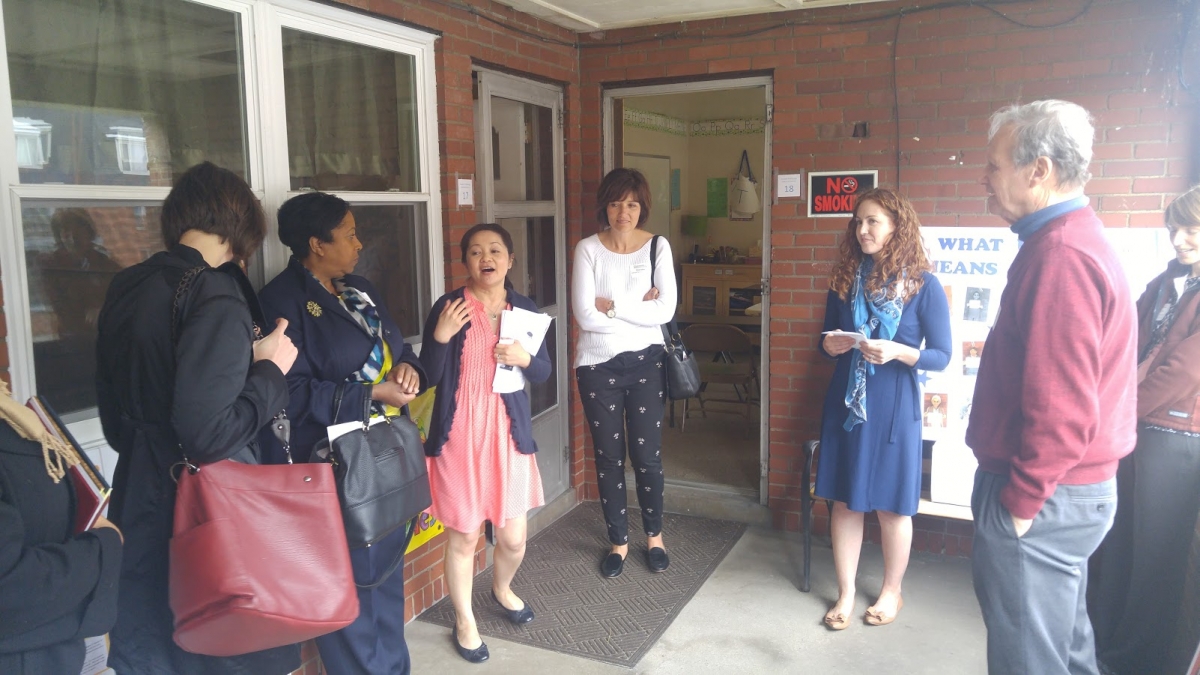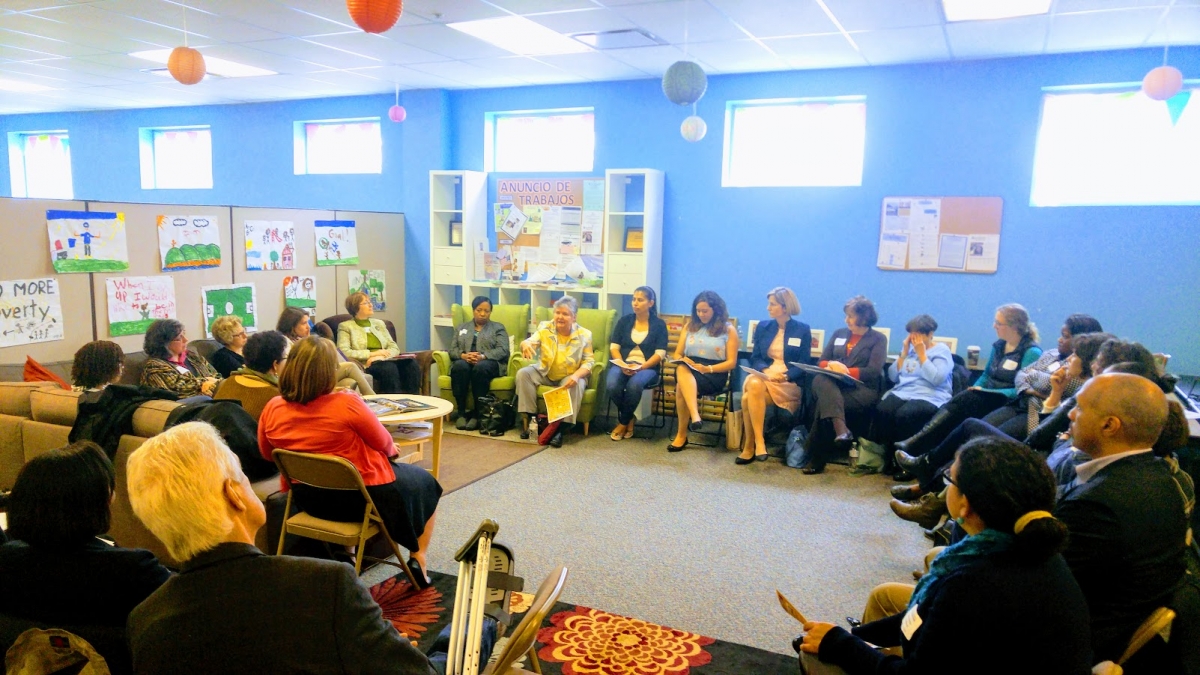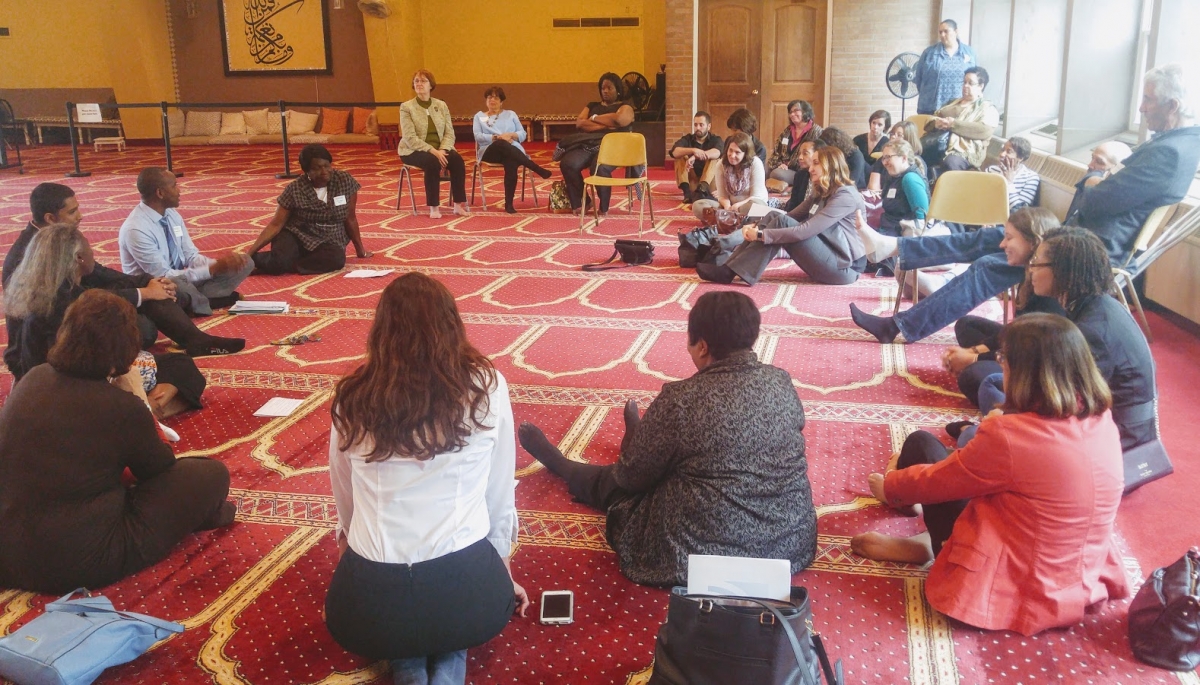Hop on the bus!
On April 24 and April 25 more than two dozen funders from Western Pennsylvania hopped on a bus to learn more about Allegheny County’s vibrant immigrant and refugee communities. The tour was organized by Grantmakers of Western Pennsyl vania in partnership with Betty Cruz of All for All, an immigrant inclusion initiative that is taking the Immigrant Community Blueprint from plan to action. While the initiative exists independent of government, it reflects a culmination of a nearly 10 year Allegheny County led effort to better integrate the growing population of refugees and immigrants into our community. From June 2015 to June 2016, a total of 173 thoughtful, committed residents including 88 immigrants, met to create a countywide blueprint that would to advance inclusive policies and practices across a variety of areas including health, language access, education, economic development, family support, and civic engagement. Participants represented numerous sectors of our community and the resulting blueprint will guide engagement of the broader community over the next 3 to 5 years.
vania in partnership with Betty Cruz of All for All, an immigrant inclusion initiative that is taking the Immigrant Community Blueprint from plan to action. While the initiative exists independent of government, it reflects a culmination of a nearly 10 year Allegheny County led effort to better integrate the growing population of refugees and immigrants into our community. From June 2015 to June 2016, a total of 173 thoughtful, committed residents including 88 immigrants, met to create a countywide blueprint that would to advance inclusive policies and practices across a variety of areas including health, language access, education, economic development, family support, and civic engagement. Participants represented numerous sectors of our community and the resulting blueprint will guide engagement of the broader community over the next 3 to 5 years.
Why it’s important?
From 2009 to 2014, Pittsburgh’s population decreased by 6/10 of a percentage point while foreign-born population grew by 13.85%. That net in migration of foreign born into Allegheny County alone represents more than 10,000 international immigrants, a group that almost single-handedly reversed what otherwise would have been a serious population decline. And that’s not surprising. Nationally, in the last 50 years, there is not a single major American city that has grown without an immigrant population. There are now more than 80,000 foreign-born residents in our region, constituting 3.4% of the total population. When immigrants thrive we all thrive. In 2014, immigrants in Pittsburgh earned some $3.2 billion, contributing over $900 million dollars in tax revenues; there are more than 4,400 immigrant entrepreneurs in the Pittsburgh Metro Area alone. Throughout our county, you will find significant Bhutanese, Burmese, Chinese, Congolese, Indian, Iraqi, Latino, Russian, Somali Bantu, Syrian, Eastern European, and Asian populations.
Why the bus?
The immigrant, refugee, and Latino population in Pittsburgh is neither homogenous nor concentrated in a particular area. Accordingly, to really understand these diverse communities, as well as the opportunities and challenges that they and Allegheny County face, we wanted to get out and truly experience this phenomenon. As part of a receiving community, it’s important that our funders understand just how critical these community members are to Pittsburgh and how, by becoming more welcoming and inclusive, we can help all of Allegheny County thrive.
Our first stop was at Wh itehall Presbyterian Church were we visited one of a number of community gardens that provide healthy food and income to refugee communities. This Church is one of a number of faith based organizations that partner closely with immigrants here in Allegheny County. It was then into the Parish Hall where we heard from a panel of presenters. Khara Timsina and Upendra Dahal shared the experiences of Bhutanese refugees and a nearly two-decade journey to Pittsburgh by way of Nepal refugee camps, and how the Bhutanese Community Association of Pittsburgh has been created to reach out to their more than 5,000 Bhutanese members. Representatives of the Greater Pittsburgh Literacy Council and South Hills Interfaith Movement (SHIM) provided more details on how Pittsburgh organizations have reached out to offer support to immigrants in a whole range of areas
itehall Presbyterian Church were we visited one of a number of community gardens that provide healthy food and income to refugee communities. This Church is one of a number of faith based organizations that partner closely with immigrants here in Allegheny County. It was then into the Parish Hall where we heard from a panel of presenters. Khara Timsina and Upendra Dahal shared the experiences of Bhutanese refugees and a nearly two-decade journey to Pittsburgh by way of Nepal refugee camps, and how the Bhutanese Community Association of Pittsburgh has been created to reach out to their more than 5,000 Bhutanese members. Representatives of the Greater Pittsburgh Literacy Council and South Hills Interfaith Movement (SHIM) provided more details on how Pittsburgh organizations have reached out to offer support to immigrants in a whole range of areas from English as a Second Language (ESL) classes and financial literacy to parenting support and afterschool programs. The bus was then off to Prospect Park where we visited the SHIM Family Support Center where we learned about the host of services provided for the international community including a food bank, an early childhood learning center, and community space.
from English as a Second Language (ESL) classes and financial literacy to parenting support and afterschool programs. The bus was then off to Prospect Park where we visited the SHIM Family Support Center where we learned about the host of services provided for the international community including a food bank, an early childhood learning center, and community space.
The takeaways from the afternoon included the significant challenges faced especially by older immigrants, as well as the incredible adaptability of the young people who integrate and thrive when provided with the opportunities we might expect all children to have.
The day ended with a visit to City of Asylum on the Northside of Pittsburgh for an inspiring tour of the Sampsonia Way international artist houses and an exhilarating program of exile poetry and literature from various countries around the world at the beautiful new Alphabet City bookstore, performance space, and restaurant in the former Masonic Temple at Federal and North Avenues. We learned about the City of Asylum’s outreach to exiled writers from nations in turmoil. A reception catered by the in-house restaurant Caselulla put a perfect exclamation point on the day as participants mingled and shared experiences.
The takeaways included a realization that immigrants and refugees have much to offer (indeed Silvia Duarte, the Assistant Executive Director of City of Asylum, became a U.S. citizen during a naturalization ceremony in January that helped to open this new City of Asylum venue) and how immigrants and refugees add vibrancy to the local arts and culture scene.
Tuesday morning opened w ith a visit to the Latino Family Center in Hazelwood. Following a tour of this family support and daycare center, a panel discussion took place featuring Rosamaria Cristello, from the Latino Family Center, Angelica Ocampo, from the World Affairs Council, Sister Janice Vanderneck of Casa San Jose, and Sheila Velez-Martinez from the University of Pittsburgh Immigration Law Clinic. These presenters provided a much deeper insight into the growing Latino community in Pittsburgh and the impact they are making despite the challenges they face.
ith a visit to the Latino Family Center in Hazelwood. Following a tour of this family support and daycare center, a panel discussion took place featuring Rosamaria Cristello, from the Latino Family Center, Angelica Ocampo, from the World Affairs Council, Sister Janice Vanderneck of Casa San Jose, and Sheila Velez-Martinez from the University of Pittsburgh Immigration Law Clinic. These presenters provided a much deeper insight into the growing Latino community in Pittsburgh and the impact they are making despite the challenges they face.
Takeaways included how much the Latino community in Pittsburgh has grown over the past decade, the barriers to integration that many face, the many contributions made to the local economy, and the fear that lingers among those who are unauthorized in the face of recent federal enforcement efforts under the Trump administration. Information from the law clinic also underscored the legal complexities of navigating a complicated immig ration system.
ration system.
Then the bus was off to Squirrel Hill and a stop at Café 33 for delicious family-style dining of gourmet Taiwanese food prepared by the immigrant small business owners. Over lunch, Jenny Tao from Café 33, Jordan Golin from Jewish Family and Children Services, David Liu, a business consultant, and Marian Lien from the Squirrel Hill Urban Coalition, discussed the thriving Asian community, especially in the East End of Pittsburgh, and its entrepreneurial spirit that has resulted in more than 30 new businesses started by immigrants in the Murray and Forbes corridors.
Takeaways included the importance of immigrant and refugee employment in Western Pennsylvania, the challenges that immigrant entrepreneurs face as they seek to comply with numerous regulations that often present both legal and cultural challenges, and the vibrancy that the immigrant population has added to the East End of Pittsburgh.
The final stop on the bus tour  was the Islamic Center of Pittsburgh where we removed our shoes and observed the midday prayer in the Center’s Prayer Hall. Wasi Mohamed provided a more in-depth look at the Muslim faith and the theology behind the five daily prayer sessions of Islam. County Executive Rich Fitzgerald discussed the importance of the immigrant community to Pittsburgh and highlighted the importance of becoming a more welcoming community. Then, a panel consisting of Wasi Mohamed, Kheir Mugwaneza, from NAMS, the area’s largest resettlement agency, Janera Solomon from Kelly Strayhorn Theater, and Yinka Aganga-Williams, Ph.D. from AJAPO, discussed the many challenges faced by refugees in seeking asylum in the United States and, thereafter, the equally great challenges of integrating into the American culture.
was the Islamic Center of Pittsburgh where we removed our shoes and observed the midday prayer in the Center’s Prayer Hall. Wasi Mohamed provided a more in-depth look at the Muslim faith and the theology behind the five daily prayer sessions of Islam. County Executive Rich Fitzgerald discussed the importance of the immigrant community to Pittsburgh and highlighted the importance of becoming a more welcoming community. Then, a panel consisting of Wasi Mohamed, Kheir Mugwaneza, from NAMS, the area’s largest resettlement agency, Janera Solomon from Kelly Strayhorn Theater, and Yinka Aganga-Williams, Ph.D. from AJAPO, discussed the many challenges faced by refugees in seeking asylum in the United States and, thereafter, the equally great challenges of integrating into the American culture.
Takeaways from the Islamic Center included a deeper insight into the Muslim faith and how much Judeo Christian and Muslim faith communities share in common and the heartbreak and pride in the journey that immigrants experience in establishing a new life in the United States. A discussion over Middle Eastern desserts bookended our experience.
What we learned on the bus.
- Understanding and sharing culture, from traditions to music to food, is a gateway to building friendships and building community.
- We all share personal or family traditions of cultural significance and sharing those experiences can broaden our own horizons and understanding.
- Get out, talk, and learn; personal connections are critical to breaking down cultural barriers and misconceptions - we all share the same dreams, hopes, and fears.
- Integrating into a new and different culture is complex and difficult in and of itself; the political challenges faced by immigrants and refugees (both in their former country and in the United States) significantly add to the challenges and complexities.
- A region can’t grow its economy without a growing population and regions can’t grow population without a growing immigrant population.
- Pittsburgh can be advanced - economically and in livability - by growing a diverse and culturally vibrant population.
Next steps:
- Join a community of learning with fellow funders to probe deeper into the importance of a growing immigrant and refugee population.
- Learn more about how addressing issues faced by immigrant population is part and parcel of addressing the challenging racial, economic, and educational divides that have troubled our region for far too long.
- Consider how sensitivity to immigrant issues can be integrated into current funding priorities as well as open up avenues for specific granting opportunities.
Below you will find a number of resources from the 2-day session. If you have any questions about this information or would like to learn more, please let us know!
Special thanks to Fred Thieman, Mary Phan-Gruber, and Betty Cruz for compiling this program synopsis!
